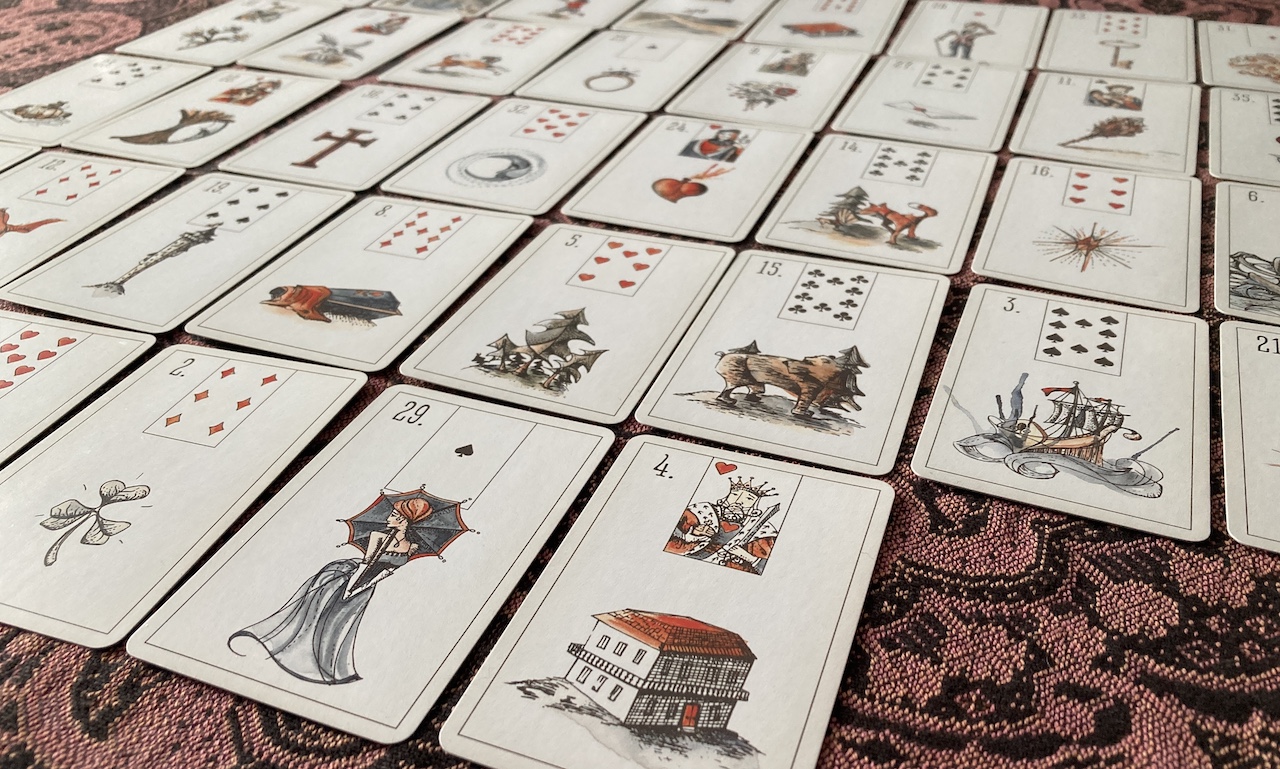I love the grand tableau, this is the spread where Lenormand really shines. There’s nothing coming close to having all 36 cards on the table, and starting to analyze a problem the same way you would look at directions on a map.
There’s nothing like a grand tableau. Even if I love the Tarot for all the advice it can give and how helpful it can be in solving problems, nothing will give you as many practical details as a Lenormand grand tableau.
I get a lot of questions about this spread. People want to know how to interpret it. While I can certainly give some form of method on how to interpret it, looking at a grand tableau is an art form. It is not about the corners mean this, that card means that, it’s about connecting everything together and coming with a coherent story.
And only practice will bring you there. I give classes, and I don’t care about giving aways my method. Like I said, in my classes we work examples and how to connect all the pieces together, method only will not make you a professional reader.
The method is easy. You look at the corners to see the influences around the problem, the middle cards to see what seems important, the first 3 cards as a first message, they give the tone to the reading.
And then you look at your significators, their lines and diagonals, and how they connect. And finally, you read the fate line, what remains after the period assigned to the reading.
As you can see, the method is easy.The art is to assign the right significators, and to work on your storytelling skills while linking all the elements together.
Let’s put all this to the test. Let’s do a grand tableau, asking “how can I best proceed to interpret a grand tableau?”
I’ll just start with two main significators, the gentleman for myself, and the letter to represent the cards.

If we start with the corners, we can see that the task of interpreting is complex and can look like climbing a mountain (snake, mountain), certainly not a walk in the park, but behind these obstacles, clarity and richness will come (sun, fish). As soon as we are past the initial shock of trying to make sense of all these cards, the story will start to develop.
As we can see in the first 3 cards (snake, garden, child), the way to work around what the corners are describing, is to consider the grand tableau as a public display where we play with all that complexity. We have to trust ourselves to be able to overcome that treacherous display.
We find the gentleman, the card that represents me as the reader, in the house of the clouds, and coffin in my own house. I’ll take that message as delivering news that will put an end to all the confusion. Everything is about discerned, well thought out, choices (crossroads, book).
And that’s exactly what we can see where the gentleman is tipping his hat, the key and the sun, the key, the solution, is to be clear. With the sun in the house of the coffin, that wraps it up nicely, make clear what is buried in the grand tableau. We’re playing detective, we’re putting light to what does not seem clear. All beautiful.
I get the letter, representing the cards, just below me. Seems normal, I’m supposed to be able to master them if I want to read. Fox in the house of the crossroads, and bear in lilies, My strong wisdom and experience are supposed to be able to strategize correcting when facing the different options presented.
Let’s look where this comes from, my past diagonal. We start with the tower in the house of the letter representing the cards. Everything has its roots into tradition. Even if we sometimes perceive the meanings as enhanced, nicely transformed (moon, bouquet), they are deeply rooted into tradition; I don’t use meanings made up on the fly, they have a basis.
Let’s look now at the letter, as it represents the cards and by extension how they are used. The letter is in the house of the fox. There’s already a warning here, the cards are not always what they appear at first view, they are sometimes misleading. The magic is to be able to control and strategize the options (man, fox in crossroads). After all the man, me, has the knowledge to find solutions that will guide compassionately the reading (book, man, key, start, heart). Enough to argue the beauty of the reading (bouquet, letter, whip).
All good. All this is similar to the center cards, the core of the reading, the ring, the bouquet, the moon, and the heart. A commitment to a beautiful and compassionate perception of the tableau.
I like to see the heart in the middle cards, and in addition it is touching the letter, the cards. Interpreting is before anything else giving compassionate solutions (heart, letter, key). After all, what would be a reading if we sometimes only gave bad news without solutions?
We could go on, read the diagonals of the letter, read the fate line, add more significators, but what would be the use? We would just start repeating the same concepts without really bringing something new. The art of reading a grand tableau is also knowing when to stop because the response to the question has been given.
Deck: Maybe Lenormand by Ryan Edward.

You must be logged in to post a comment.